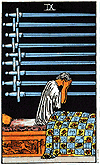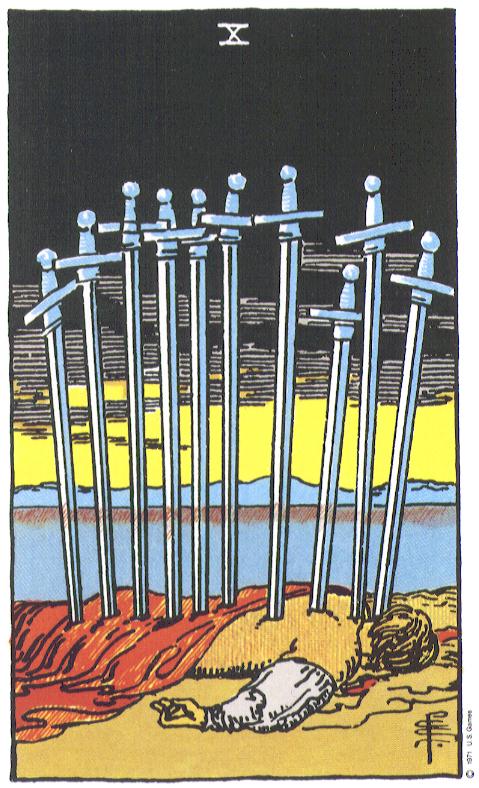

 |
 |
| A tarot deck typically has 78
cards. There are 22 Major Arcana cards which have deep archetypal meaning. Sixteen Court cards represent the King, Queen, Knight and Page of each of the 4 suits. Then there is the ace to 10 of each suit. The suits are cups, wands, pentacles and swords, corresponding to water, fire, earth and air respectively. Since there are hundreds of different decks, these names and correspondences vary somewhat. The tarot cards have a connection with the Qabalistic Tree of Life. In the case of the ace to l0's, aces have affinity with Kether on the tree, and therefore contain the idea of beginnings, Tens relate to Malkuth, the l0th station on the tree, the manifest world as we know it. Tens therefore suggest the fullness of their suit, the theme of the suit carried to its logical conclusion. |
|
 |
 |
||||||
| 9 of swords | 10 of swords |
| This site is primarily
interested in swords, the darkest, dreariest and most problematic cards in
the deck. The suit of cups contains much of love and light; but look,
we know that troubles are a dime a dozen while we have to scrape and
struggle so much to obtain even the slightest bit of pleasure! One can
get taken down walking around any physical or emotional corner of
life, while sadly it is much rarer for good things to drop into your
lap. So on to swords! Swords cut. If you take the "s" away from swords, you get "words" and words cut too. Swords are sharp. They stand for intellectual clarity--and what reasonable person wants that?!Swords are associated with the element of air, an element which brings much turbulance and stormy weather. The ace of swords presents the problem of the suit. In the Ryder deck, the sword is piercing the crown of the material world. Wisdom can move us from illusion to truth. But you also need a touch of intuition in there or you will be led right back to illusion. One actually needs a balance of intellect, emotion, sensation and intuition--and you still might get cut! The two of swords suggests ways of handling the problems, all unhelpful. We can get our backs up, we can go into denial, we can retreat emotionally, we can quit the game. To refuse to play is to refuse to risk being hurt--but don't count on it. You can get hurt anyway. The three of swords is the taking of the pain into our hearts. There, you have to accept the pain and move beyond it, and try to transform it. But you can't avoid the pain. The three is a card of loss. Losing something you never actually had is perhaps the most unkindest cut of all. The four of swords gives a moment of stability, a brief respite from the conflict. Fours tend to be benevolent, as they correspond with Chesed/Jupiter on the Tree of Life. Temporary withdrawal is a good way to recoup one's strength. But if the withdrawal lasts too long, then you might not be able to get back into the swing of things again. Fives tend toward malevolence, corresponding with Geburah/Mars on the Tree. The five of swords is no exception. The battle has been fought and the other guy has won....unless we're the other guy. Our worst enemy is usually ourself. |
 |
The six is the journey by water. The image of a ferryboat at dusk carrying the shrouded figures off is certainly one of the most evocative images in the deck. Almost anyone would feel sad looking at the card. One gets the idea of an escape, but not an escape from one's troubles. One thinks of Charon ferrying the dead across the river styx. |
|
| 6 of swords |
| The seven of swords
suggests a sneaky, impulsive and ineffective act. It can also suggest
that you cover your back. The eight gives an image of oppression. There might be a way out of the problem situation, but you have to see it first. And society has all kinds of ways for making sure that people don't see it and that they remain in their place. The nine gives an image of sorrow most deep. All of us have awakened in the middle of the night, felt very, very alone and let our imaginations run riot. Worries flood the mind. And again--words are swords. Something a teacher or a parent might have said 50 years ago can continue to cut and cut and cut. The ten of swords is one of the most devastating cards in the deck. It suggests a physical attack, knives in the back; violence, ruination. Some tarot theorists tend to soften the blow by saying that the l0 swords in the back are overkill; in other words, the problem merely seems terrible. It has even been suggested that if you reverse the card, the swords all fall out. When did you ever roll someone over who's been stabbed in the back and have the knife fall out? Mostly, when someone drives in the knife, they juggle it around and that's it, folks. |
|